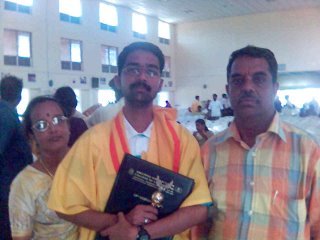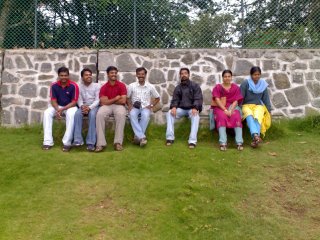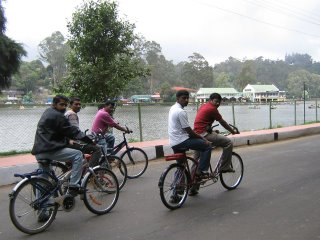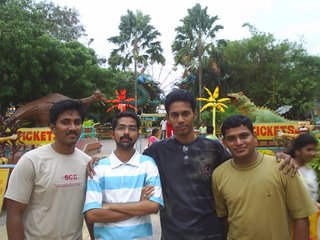Sunday, July 26, 2009
Wednesday, July 04, 2007
Tuesday, July 11, 2006
Tuesday, November 30, 2004
MY COUNTRY - INDIA
India
Introduction
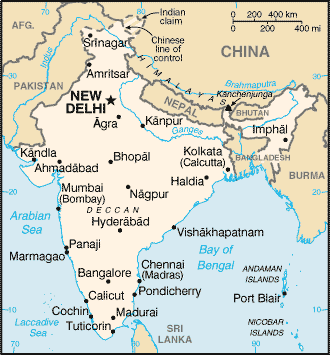
From the earliest settlements along the Indus River, the Dravidians and later the Aryans spread their settlements deep into the sub-continent. Protected by geographic barriers, the valley inhabitants had limited contact with the outside world. Farmers cultivated cotton and processed it into cloth which became a valuable trade commodity. Their cities were well planned with shops, granaries, extensive sewer systems and protective walls. Two major religions, Buddhism and Hinduism, developed in India and spread throughout Asia.
Art served religion well in India. The artists of the area cut unique Buddhist Temples from rocky cliffs with facades and interiors intricately carved to imitate the wooden constructions of the period. From the earliest simple structures to the ornate and imposing later ones, the Hindu Temples must be appreciated as sculpture as well as architecture. Their paintings, particularly from the Gupta dynasty, are classed as some of the finest in history.
LET US BEGIN WITH THE ARYANS:
THE ARYANS:
They called themselves the "noble ones" or the "superior ones." Their names are lost; their tribal names are lost. But when they found themselves conquerors, they gave themselves the name "superior" or "noble."
They were a tribal and nomadic peoples living in the far reaches of Euro-Asia in hostile steppe lands barely scratching out a living. They were unquestionably a tough people, and they were fierce and war-like. Their religion reflects it dominated as it is by a storm-god or sky-god that enjoins warfare and conquest. This god was called something like "Dyaus," a word related to "Zeus," "deus" (the Latin word for "god"), "deva" (the Sanskrit word for "god"), and, of course, the English word "divine." Their culture was oriented around warfare, and they were very good at it. They were superior on horseback and rushed into battle in chariots. They were a tribal people ruled over by a war-chief, or raja (the Latin word "rex" (king) comes from the same root word, along with the English "regal"). Somewhere in the early centuries of the second millenium BC, they began to migrate southwards in waves of steady conquest across the face of Persia and the lands of India.
There, they would take on the name "superior" or "noble" to distinguish themselves from the people they conquered. Their name is derived from the Indo-European root word, "ar," meaning "noble." In Sanskrit, they were the "Aryas" ("Aryans"); but that root, "ar," would also serve as the foundation of the name of the conquered Persian territories, "Iran." This concept of nobility, in fact, seems to lie at the heart of Indo-European consciousness, for it appears in another country's name, "Ireland," or "Eire." You can bet, however, that when a people go around calling themselves superior that it spells bad news for other people.
And there is no question that they were bad news for the southern Asians. They swept over Persia with lightening speed, and spread across the northern river plains of India. Their nature as a warlike, conquering people are still preserved in Vedic religion, the foundation of Hinduism. In the Rig Veda, the collection of praises to the gods, the god Indra towers over the poetry as a conquering god, one that smashes cities and slays enemies. The invading Aryans were originally nomadic peoples, not agricultural. They penetrated India from the north-west, settling first in the Indus valley. Unlike the Harappans, however, they eventually concentrated their populations along the Ganges floodplain. The Ganges, unlike the Indus, is far milder and more predictable in its flooding. It must have been a paradise to a people from the dry steppes of central Asia and Iran, a paradise full of water and forest. When they arrived, the vast northern plains were almost certainly densely forested. Where now bare fields stretch to the horizon, when the Aryans arrived lush forests stretched to those very same horizons. Clearing the forests over the centuries was an epic project and one that is still preserved in Indian literature.
The Aryans, or Vedic civilization were a new start in Indian culture. Harappa was more or less a dead end (at least as far as we know); the Aryans adopted almost nothing of Harappan culture. They built no cities, no states, no granaries, and used no writing. Instead they were a warlike people that organized themselves in individual tribal, kinship units, the jana. The jana was ruled over by a war-chief. These tribes spread quickly over northern India and the Deccan. In a process that we do not understand, the basic social unit of Aryan culture, the jana, slowly developed from an organization based on kinship to one based on geography. The jana became a janapada, or nation and the jana-rajya , or tribal kingdom, became the jana-rajyapada, or national kingdom. So powerfully ingrained into Indian culture is the jana-pada , that Indians still define themselves mainly by their territorial origins. All the major territories of modern India, with their separate cultures and separate languages, can be dated back to the early jana-padas of Vedic India.
The earliest history of the Aryans in India is called the Rigvedic Period (1700-1000 BC) after the religious praise poems that are the oldest pieces of literature in India. These poems, the Rig Veda, are believed to represent the most primitive layer of Indo-European religion and have many characteristics in common with Persian religion since the two peoples are closely related in time. In this early period, their population was restricted to the Punjab in the northern reaches of the Indus River and the Yamuna River near the Ganges. They maintained the Aryan tribal structure, with a raja ruling over the tribal group in tandem with a council. Each jana seems to have had a chief priest; the religion was focused almost entirely on a series of sacrifices to the gods. The Rigvedic peoples originally had only two social classes: nobles and commoners. Eventually, they added a third: Dasas , or "darks." These were, we presume, the darker-skinned people they had conquered. By the end of the Rigvedic period, social class had settled into four rigid castes: the caturvarnas, or "four colors." At the top of the caturvarnas were the priests, or Brahmans. Below the priests were the warriors or nobles (Kshatriya), the craftspeople and merchants (Vaishya), and the servants (Shudra), who made up the bulk of society. These economic classes were legitimated by an elaborate religious system and would be eventually subdivided into a huge number of economic sub-classes which we call "castes." Social class by the end of the Rigvedic period became completely inflexible; there was no such thing as social mobility.
In the early centuries of Later Vedic Period or Brahmanic Period (1000-500 BC), the Aryans migrated across the Doab, which is a large plain which separates the Yamuna River from the Ganges. It was a difficult project, for the Doab was thickly forested; the Aryans slowly burned and settled the Doab until they reached the Ganges. While the Rig Veda represents the most primitive religion of the Aryans during the Rigvedic Period, the religion of the Later Vedic period is dominated by the Brahmanas, or priestly book, which was composed sometime between 1000 and 850 BC. Later Vedic society is dominated by the Brahmans and every aspect of Aryan life comes under the control of priestly rituals and spells. In history as the Indians understand it, the Later Vedic Period is the Epic Age; the great literary, heroic epics of Indian culture, the Mahabharata and the Ramayana, though they were composed between 500 and 200 BC, were probably originally formulated and told in the Later Vedic Period. Both of these epics deal with heroes from this period and demonstrate how Aryan cultural values, as we can understand them from the Rig Veda , are being transformed by mixing with Indus cultures.
What did the Aryans do with their time? They seem to have had a well-developed musical culture, and song and dance dominated their society. They were not greatly invested in the visual arts, but their interest in lyric poetry was unmatched. They loved gambling. They did not, however, have much interest in writing even though they could have inherited a civilization and a writing system when they originally settled India. We do not know exactly when they became interested in writing, but it may have been at the end of the Brahmanic period somewhere between 650 and 500 BC. Still, there are no Aryan writings until the Mauryan period—from Harappa (2500-1750 BC) to Maurya (300 BC) is quite a long time. The script that the Mauryans used is called "Brahmi" script and was used to write not only the religious and literary language of the time, Sanskrit, but also the vernacular languages. This script, Brahmi, is the national alphabet of India.
A GENERAL OVERVIEW:
------------------
In the conventional narrative, Indian history begins with the birth of the Indus Valley Civilization in such sites as Mohenjo-Daro, Harappa, and Lothal, and the coming of the Aryans. These two phases are usually described as the pre-Vedic and Vedic perio ds. It is in the Vedic period that Hinduism first arose: this is the time to which the Vedas are dated. In the fifth century, large parts of India were united under Ashoka; he also converted to Buddhism, and it is in his reign that Buddhism spread to o ther parts of Asia. It is in the reign of the Mauryas that Hinduism took the shape that fundamentally informs the religion down to the present day. Successor states were more fragmented. Islam first came to India in the eighth century, and by the eleve nth century had firmly established itself in India as a political force; the North Indian dynasties of the Lodhis, Tughlaqs, and numerous others, whose remains are visible in Delhi and scattered elsewhere around North India, were finally succeeded by the Mughal empire, under which India once again achieved a large measure of political unity.
The European presence in India dates to the seventeenth century, and it is in the latter part of this century that the Mughal empire began to disintegrate, paving the way for regional states. In the contest for supremacy, the English emerged 'victors', their rule marked by the conquests at the battlefields of Plassey and Buxar. The Rebellion of 1857-58, which sought to restore Indian supremacy, was crushed; and with the subsequent crowning of Victoria as Empress of India, the incorporation of India into the empire was complete. By the early part of the twentieth century, a nationalist movement had emerged; and b y 1919-20, Mohandas Karamchand ('Mahatma') Gandhi had emerged as the virtually undisputed leader of this movement. Successive campaigns had the effect of driving the British out of India in 1947, but not before they had partitioned it, and carved out th e state of Pakistan -- later dismembered into Pakistan and Bangladesh.
The gradual emergence of India as a self-governing entity had been partly envisioned in the Government of India Act of 1935, and following India's independence in 1947, the Constituent Assembly deliberated over the precise constitutional future of India. On 26 January 1950, India became a Republic, and the Constitution of India was promulgated. The Indian National Congress, which had led the country to freedom, remained the largest and most influential party under the stewardship of Jawaharlal Nehru, who served as India's Prime Minister from 1947 to 1964. His 'regime' was marked by the advent of five-year plans, designed to bring big science and industry to India; in Nehru's own language, steel mills and dams were to be the temples of modern India. Relations with Pakistan remained chilling, and the purported friendship of India and China proved to be something of a hoax, when China invaded India's borders in 1962.
Nehru was succeeded at his death by Lal Bahadur Shastri, who led the country to something of a victory over Pakistan in 1965; he could not even relish the thought of triumph, dying of a heart attack the day after the treaty was signed. He was succeeded by Indira Gandhi, Nehru's daughter. By the late 1960s, Indira Gandhi had engineered a split in the Congress, as the only means to ensure her political survival, and the Congress had been reduced to a sh adow of its former self. In 1971, India crushed Pakistan in a short war that also saw the birth of Bangladesh, and Indira was now at the helm of her powers. But the shine wore off, and as domestic problems mounted and popular movements directed at her b egan to show their effect, she resorted to more repressive measures. An internal emergency, which placed almost the entire opposition behind bars, was proclaimed in May 1975, and only removed in 1977; and the same opposition, which hastily convened to ch art its strategy, achieved in delivering the Congress party its first loss in national elections. This government, serving various political interests, lasted a mere three years, and Indira Gandhi rode a large wave of victory in 1980. But she did not li ve to complete her term: shot by her own Sikh bodyguards, who sought to avenge the destruction unleashed upon the Golden Temple, the venerable shrine of the Sikh faith, by Indian government troops given the task of flushing out the terrorists holed in th e shrine, she was succeeded by her son, Rajiv Gandhi. The Congress has since held power, but for another interim period of less than two years between 1989 and 1991, and is now under the helm of Narasimha Rao.
Tuesday, November 23, 2004
my cosmos
hai,
in my point of view we are not aware of what earth is.
my suggestion is as follows:
the electrons move around the nucleus , as our earth moves around the sun.
the electron is a smallest part of a big structure.
similarly our earth is also a smallest part of the big structure. but we donot know about the big stucture because our knowledge is limited.



